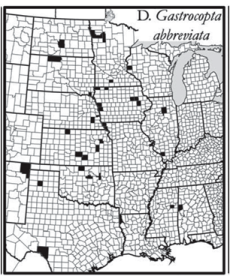There is No Place Like Home...
Habitat type: terrestrial
Gastrocopta abbreviata inhabitats mainly the central and western plains
of the United States; more specifically, this organism can be
found under stones, within loess bank fissures, and in thin
litter concentrations in riparian forests and grasslands within
these regions. However, as we turn to examine the members of this species that dwell further to
the east, we find
that their environment contrasts significantly to their Western
siblings: they inhabit
drier environments, like those associated with bedrock outcrops
or sand deposits (Nekola and Coles, 2010). Although the
presented information seems to contradict itself, the reason for
this species' change in habitat preference is due to
the increased humidity that is characteristic of the Eastern region of the U.S.
For this reason, it is not necessary for the snail to remain as
close to water which enables it to venture further
inland and survive these
drier environments.
Specific states within the continental United States in which
G. abbreviata has been found
include: Alabama, Iowa, Illinois, Kansas, Louisiana, Minnesota, Missouri, Mississippi, North Dakota, Nebraska, New Mexico,
Oklahoma, South Dakota, Texas, and Wisconsin (Hubricht, 1972).
However, Gastrocopta abbreviata is not the only
creature that has taken a liking to these particular habitats.
In fact, it has been found that this
species frequently co-exists with Gastrocopta armifera and Gastrocopta similis;
however, intermediate individuals never result from this overlap
in habitat (NatureServe,
2011).
A possible reason that Gastrocopta abbreviata does not appear in other areas of the U.S. may simply be due to certain barriers that impede Gastrocopta abbreviata from further dispersal. A few examples of barriers that directly affect G. abbreviata include: permanent bodies of water that are larger than 30 meters in width, permanently frozen areas (e.g. mountaintop glaciers), or exceptionally dry environments that receive less than six inches of precipitation a year (NatureServe, 2011).
What kind of Interesting facts are known about this species?
Click here to return Home.

